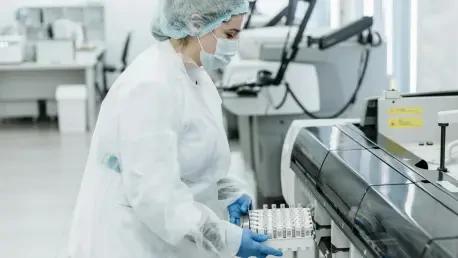In an era where healthcare systems are grappling with unprecedented demand, automation has emerged as a transformative force, shifting from a mere efficiency tool to a cornerstone of patient care and clinical success. Hospitals and clinics face relentless pressure to improve outcomes while managing limited resources, and technology is stepping in to address these challenges with remarkable precision. No longer confined to mundane tasks like data entry, automation now encompasses intelligent systems that streamline complex workflows, enhance decision-making, and support overburdened staff. This evolution is not just about saving time; it’s about fundamentally reshaping how care is delivered, ensuring patients receive timely and accurate attention. As the industry navigates rising costs and growing patient volumes, the integration of advanced automation offers a promising path forward, sparking curiosity about how far this technological shift can take healthcare in achieving better results.
The Evolution of Automation in Patient Care
The journey of automation in healthcare reveals a striking transformation, moving far beyond its initial role of handling repetitive administrative tasks to becoming an integral part of clinical excellence. What began as basic Robotic Process Automation (RPA) for tasks like scheduling and billing has grown into sophisticated systems capable of interpreting intricate data sets and making real-time decisions. These intelligent tools can now prioritize urgent cases, flag anomalies in patient records, and even suggest treatment pathways based on vast medical databases. Driven by the sheer volume of demands on healthcare professionals, this shift ensures that staff are relieved from routine burdens, allowing more time for direct patient interaction. The result is a system where technology and human expertise work in tandem, creating an environment where care delivery is not only faster but also more precise, ultimately benefiting those who need it most.
This evolution also reflects a deeper understanding of healthcare’s unique needs, where adaptability and accuracy are non-negotiable. Unlike earlier automation models that followed rigid, rules-based protocols, today’s systems leverage artificial intelligence to handle nuanced scenarios that defy straightforward categorization. For instance, they can process unstructured data from patient notes or imaging scans, turning raw information into actionable insights without constant human oversight. This capability is vital in an industry where delays or errors can have serious consequences. As automation continues to mature, it’s clear that the focus is shifting toward enhancing clinical outcomes rather than just cutting operational costs. The integration of such technology signals a future where healthcare providers can meet rising expectations without sacrificing quality, setting a new standard for what efficient care looks like in practice.
Challenges in Scaling Automation Systems
Implementing automation in healthcare, while promising, comes with a set of formidable obstacles that must be carefully navigated to ensure success. Pilot projects often demonstrate impressive potential, showing how technology can streamline processes like patient intake or claims processing with ease. However, transitioning these small-scale trials into fully operational, large-scale systems reveals significant hurdles. Healthcare data is notoriously unpredictable, often lacking uniformity across providers or even within a single facility, which can disrupt automated workflows. Moreover, the stakes are incredibly high—any glitch or miscalculation risks patient safety, making reliability a top priority. This necessitates rigorous testing and continuous refinement to adapt to real-world complexities, ensuring that automation complements rather than compromises the delicate balance of care delivery.
Beyond technical challenges, there’s also the critical need to maintain trust and accountability within automated systems. To address potential failures, healthcare organizations are embedding robust safeguards, such as validation checks and clear escalation paths for human intervention when anomalies arise. These mechanisms are essential to prevent errors from spiraling into serious issues, particularly in sensitive areas like medication dispensing or diagnostic support. Additionally, staff training plays a pivotal role, as employees must feel confident interacting with these tools and understanding their limitations. The goal is to create a seamless partnership between technology and human judgment, where automation handles high-volume tasks while clinicians retain oversight for nuanced decisions. Overcoming these implementation barriers requires a commitment to patience and precision, but the payoff—improved efficiency without sacrificing safety—makes the effort indispensable for modern healthcare systems.
Advancing with Intelligent Agent-Based Automation
A significant leap in healthcare automation is the shift from traditional RPA to more dynamic, agent-based systems that tackle complexity with unprecedented finesse. Early RPA tools, while useful for repetitive tasks, often faltered when faced with inconsistent or variable inputs, leading to workflow interruptions that required manual fixes. Now, intelligent agents built on top of RPA frameworks bring a layer of adaptability, enabling systems to process diverse data formats and make context-aware decisions. A practical example lies in managing medication refill requests, where forms from various pharmacies differ widely in structure. These advanced systems can interpret such variability, extract relevant details, and route exceptions to staff for review, ensuring no request slips through the cracks. This marks a profound improvement in operational flow and patient service.
The impact of agent-based automation extends further, enhancing how healthcare providers manage intricate administrative burdens without draining human resources. By integrating artificial intelligence, these systems not only execute tasks but also learn from patterns, continuously improving their accuracy over time. This means fewer errors in critical processes like insurance verification or referral coordination, areas where delays can frustrate patients and strain provider relationships. Additionally, tools designed for seamless handoffs—such as action centers where staff can address edge cases—ensure that automation doesn’t operate in isolation but as a supportive extension of the workforce. This transition underscores a broader trend: technology in healthcare is evolving to handle not just the predictable but the ambiguous, paving the way for a more resilient infrastructure that prioritizes both efficiency and patient well-being in equal measure.
Strategic Collaborations Fueling Technological Progress
Partnerships between healthcare organizations and technology innovators are proving to be a driving force behind automation’s transformative impact on the industry. Rather than focusing on minor, incremental gains, these collaborations target high-stakes challenges that resonate with clinical and financial priorities, ensuring meaningful change. By aligning automation initiatives with the goals of hospital leadership, such as improving patient throughput or reducing denial rates in billing, these efforts gain crucial support and resources. The emphasis on impactful solutions means that technology isn’t just a novelty but a strategic asset, capable of delivering measurable improvements in care quality and operational performance. Such alliances demonstrate how shared vision and expertise can turn ambitious concepts into tangible benefits for patients and providers alike.
These strategic relationships also foster an environment of innovation by combining deep industry knowledge with cutting-edge technical capabilities. Healthcare providers bring insights into the nuanced pain points of daily operations, while tech partners contribute advanced tools like machine learning algorithms and scalable automation platforms. This synergy enables the development of solutions tailored to real-world needs, such as automating complex denials management workflows that previously consumed countless staff hours. Furthermore, focusing on high-impact areas helps build a compelling case for wider adoption across organizations, encouraging other stakeholders to embrace change. As these collaborations grow, they set a precedent for how technology can be integrated thoughtfully, ensuring that automation serves as a catalyst for systemic improvement rather than a superficial fix.
Ensuring Reliability and Trust in Automated Care
As automation becomes deeply embedded in healthcare operations, prioritizing system reliability emerges as a fundamental concern to protect patient well-being. The industry is keenly aware that while technology offers immense potential to alleviate workload pressures, any lapse in performance could have dire consequences. To mitigate risks, providers are designing systems with multiple layers of protection, including real-time error detection and protocols for immediate human intervention when needed. This cautious approach ensures that automation acts as a dependable ally, supporting clinicians without overstepping into areas where human judgment remains irreplaceable. The focus on resilience reflects a broader commitment to balancing innovation with the ethical imperative of maintaining high standards in care delivery.
Building trust in these systems also involves transparent integration and continuous evaluation to address any shortcomings promptly. Healthcare organizations are investing in frameworks that allow for ongoing monitoring and updates, ensuring that automation adapts to evolving clinical practices and regulatory requirements. Equally important is fostering confidence among staff and patients, who must view technology as a helpful tool rather than a threat to personalized care. By embedding clear accountability measures, such as audit trails for automated decisions, providers can demonstrate that patient safety remains paramount. This balanced strategy highlights the industry’s dedication to harnessing automation’s benefits while safeguarding the human element at the heart of healthcare, creating a model where technology and trust coexist harmoniously.
Reflecting on Automation’s Impact and Future Steps
Looking back, the integration of automation into healthcare marked a pivotal shift, addressing urgent demands with innovative solutions that reshaped patient care. The journey from basic task automation to intelligent, agent-based systems demonstrated how technology adapted to the sector’s unique challenges, enhancing both efficiency and clinical outcomes. Strategic partnerships played a crucial role, driving focused advancements that tackled significant issues rather than superficial fixes. Challenges in scaling and ensuring reliability were met with diligent efforts to build safeguards, preserving trust in these systems. Moving forward, the next steps involve deepening these collaborations to refine automation further, prioritizing interoperable solutions that integrate seamlessly across diverse platforms. Continuous investment in staff training will also be essential to maximize technology’s potential, ensuring that healthcare evolves into a space where innovation consistently supports better, safer, and more equitable care for all.









